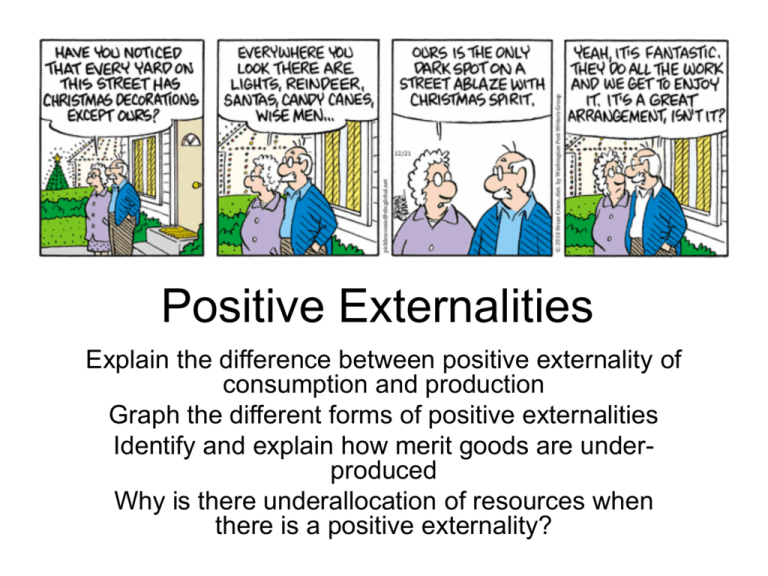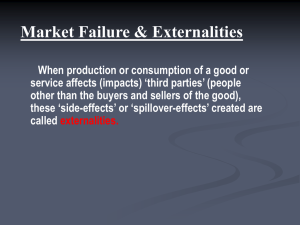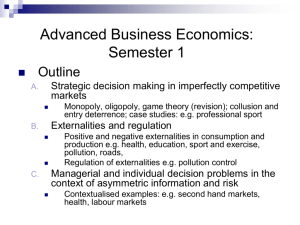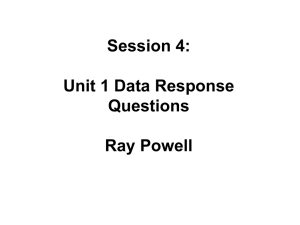Positive Externalities - Arlington Public Schools
advertisement

Positive Externalities Explain the difference between positive externality of consumption and production Graph the different forms of positive externalities Identify and explain how merit goods are underproduced Why is there underallocation of resources when there is a positive externality? Types of market failure • Externalities – MSC>MPC, negative externalities – MSB>MPB, positive externalities • Under- and over-provision of goods – Merit goods/public goods (underprovided—see positive externalities) – Demerit goods (overprovided—see negative externalities) • Imperfect competition – Oligopoly/monopoly means that the market has failed to provide more at a lower price without firms making a loss (decreases consumer surplus) • Common access resources – i.e., ocean, forests – Lack of clear ownership rights means there’s too weak an incentive for anyone to take care of resources, resulting in over-use/sub-optimal allocation Positive externalities of production • For third parties to benefit from the production of a good, the positive spillover effects must exist whether the good is consumed or not! • Usually, this means that more often than not, these are indirect positive externalities • Positive externalities of production are external benefits created by producers (MPC > MSC) and MSB=MPB So, what’s the problem? • Positive externalities create merit goods—a good deemed so beneficial that society deems the good to be underprovided by free market forces Examples of merit goods: • Education • Health care • Pensions • Wind/solar power energy • Public housing • As a result, the good is also underconsumed since consumers lack sufficient information to consume the “correct” amount – Welfare loss (positive production) Welfare loss Welfare loss (positive production) • Underallocation of resources to production with a positive production externality leads to welfare loss (not enough produced) • Loss= difference between MSB and MSC curves relative to optimal output (point of wl triangle is at Qopt quantity of output) Encouraging positive externalities Increasing supply • Government grants and subsidies to producers that generate external benefits will reduce costs of production, and encourage more supply. This is a common remedy to encourage the supply of merit goods/public goods • Such merit goods can be funded out of taxation Increasing demand • Demand for goods that create positive externalities, can be encouraged by reducing the price paid by consumers, such as subsidizing the tuition fees, or make the good completely free at the point of consumption, such as free hospital treatment for contagious diseases. • Government can provide free information to consumers, which could help develop a better understanding of the product and demand more of it. For example, AIDS awareness programs can reduce ignorance and encourage the use of protection. • An additional option is to compel individuals to consume the good or service that generates the external benefit. In terms of education, attendance at school up until the age of 16 is compulsory, and parents may be fined. Correcting positive production externalities • Subsidies – The gov’t provides subsidy to a firm per unit of good produced, equal to the external benefit – Paid for by taxes – Shifts MPC curve towards MSC to increase quantity to Qopt, while price falls to Popt – Gov’t provision and subsidies have the same market outcomes Correcting positive production externalities • Direct government provision – The gov’t provides the g/s creating the positive production externality (R&D) – Paid for by taxes – Shifts supply curve right toward MSC, so that Qopt (optimal Q) will be produced, with price falling from Pm to Popt Positive externalities of consumption • For third parties to benefit from the consumption of a good, the positive spillover effects must exist whether the good is consumed or not! • Usually, this means that more often than not, these are indirect positive externalities • Positive externalities of consumption are external benefits created by consumers (MSB > MPB) and MPC=MSC Positive externalities of consumption








